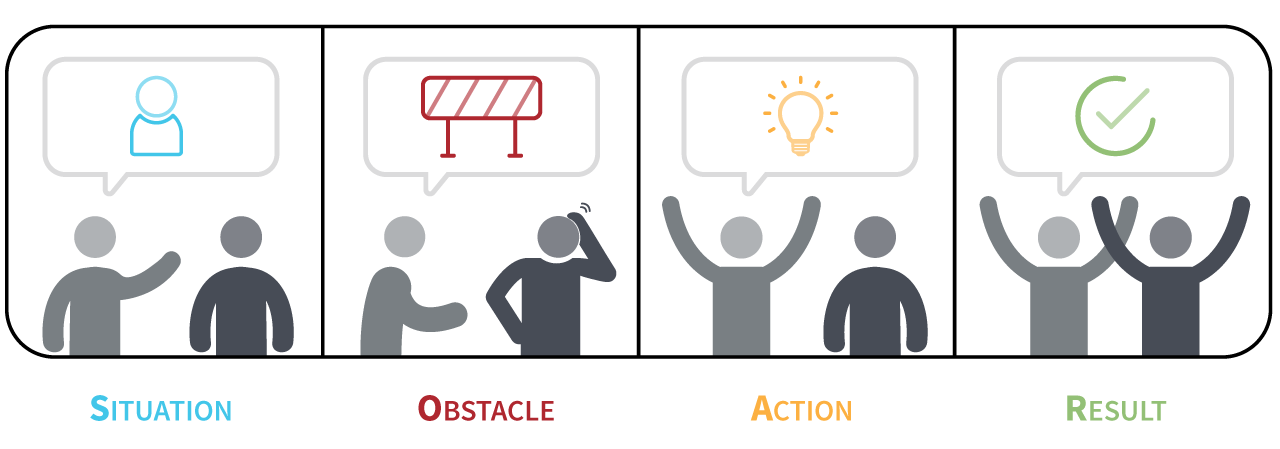Use these verbs
Analyzed
Collaborated
Conducted
Controlled
Coordinated
Created
Designed
Developed
|
Established
Evaluated
Executed
Generated
Implemented
Improved
Increased
Launched
|
Led
Maximized
Organized
Prepared
Quantified
Reduced
Secured
Strengthened
|
Here are some best practices for summarizing your work experience with bullets:
Focus on relevant responsibilities
You won’t be able to list all of your job duties. Instead, focus on the most impressive and relevant ones. Highlight tasks that required a high skill level or specialized knowledge and any additional responsibilities you took on, such as training other employees or managing large amounts of money.
For example, imagine you are a laboratory assistant looking to become a laboratory scientist. At your current position, you’ve led some small research projects, co-authored an article, interviewed study participants, and performed data entry. You should avoid listing “data entry” on your resume. A hiring manager would be considerably more impressed with your other accomplishments. If in the course of this data entry, however, you mastered an important software suite or navigated a complex database used across organizations, you may consider writing that. Those experiences go beyond “data entry.”
Begin bullet statements with verbs.
Use a variety of verbs throughout your resume. For current jobs, use the present tense; all previous jobs should use the past tense. Make sure these verbs are active. For example, “Processed,” is a good way to start a bullet statement. On the other hand, “Was responsible for processing,” is not active, so you shouldn’t use it. Some powerful verbs include:
Analyzed
Collaborated
Conducted
Controlled
Coordinated
Created
Designed
Developed
|
Established
Evaluated
Executed
Generated
Implemented
Improved
Increased
Launched
|
Led
Maximized
Organized
Prepared
Quantified
Reduced
Secured
Strengthened
|
For example, as a laboratory assistant, you may say that you “Co-authored an article published in industry-leading journal Laboratory Monthly” to emphasize your active role and the prestige of publishing an article with that particular publication. If applying for a job within the same scientific field, however, you may leave off “industry-leading.” Anyone actively working in that field would probably know which publications are industry-leading.
Quantify your accomplishments.
Each statement should also include numbers and time frames that quantify your impact and abilities. “Processed cash and credit transactions” is not a bad bullet statement, but “Processed up to $2,000 in cash and credit transactions daily” is much better. “Crafted and served up to 200 specialty coffee drinks per shift” is much more impressive than “Served coffee.”
For example, as a laboratory assistant, you may say that you “Conducted interviews about political preferences with over 300 people from all walks of life.”
There are some circumstances in which quantifying your accomplishments is inappropriate. Use your best judgment and do not disclose any information that your employer requests you keep private. If there is ever a question of whether something is appropriate to include, simply ask your employer.
Start strong.
Remember that hiring managers typically read your resume in an F pattern, or by scanning down the left side of the page and following anything that looks interesting. To catch their eyes, make sure to lead your bullet statements with your most impressive accomplishments.
For example, the previous bullet point does not start strong. You could rephrase it to shift the focus: “Interviewed over 300 people from all walks of life about their mental health.”
Do not embellish.
Overselling your experiences may get you a lot of initial attention, but it will not pay off in the long term. If it appears you’ve misrepresented some or all of your qualifications, suspicious employers will either ignore your resume altogether or investigate your claims. Your credibility and reputation suffer when you misrepresent yourself.
For example, as a laboratory assistant, you may say that you “Led several large-scale, long-term projects,” but that wouldn’t be true. Instead, report only facts: “Led several small-scale research projects from hypothesis to conclusion.” It’s impressive for a laboratory assistant to lead a few small-scale projects, but it’s unusual (and perhaps suspicious) for them to lead several large-scale, long-term projects.
It will take you several revisions to get these bullet statements right. For each new job application, you should revisit your bulleted lists and customize them to fit the role. Emphasize the accomplishments and responsibilities most relevant to a particular position.
Your Name
Home
Address • City, State Zip
Phone
Number • Name@fullbridge.com
SUMMARY
Insert tailored version of your personal pitch
EDUCATION
Name
of University
Degree
and Concentration (GPA is optional)
WORK EXPERIENCE
Organization City,
State
Position
Title Month Year –
Month Year
·
Lead with action verb / Quantify if
possible / Remember tense / Detail accomplishments
·
Lead with action verb / Quantify if
possible / Remember tense / Detail accomplishments
·
Lead with action verb / Quantify if
possible / Remember tense / Detail accomplishments
·
Lead with action verb / Quantify if
possible / Remember tense / Detail accomplishments
Organization City,
State
Position
Title Month Year –
Month Year
·
Lead with action verb / Quantify if
possible / Remember tense / Detail accomplishments
·
Lead with action verb / Quantify if
possible / Remember tense / Detail accomplishments
·
Lead with action verb / Quantify if
possible / Remember tense / Detail accomplishments
·
Lead with action verb / Quantify if
possible / Remember tense / Detail accomplishments
Organization City,
State
Position
Title Month Year –
Month Year
·
Lead with action verb / Quantify if
possible / Remember tense / Detail accomplishments
·
Lead with action verb / Quantify if
possible / Remember tense / Detail accomplishments
·
Lead with action verb / Quantify if
possible / Remember tense / Detail accomplishments
·
Lead with action verb / Quantify if
possible / Remember tense / Detail accomplishments
ADDITIONAL SKILLS
Software
Proficiency
·
Bullet statement listing relevant
skilled or grouped talents
·
Bullet statement listing relevant
skilled or grouped talents
·
Bullet statement listing relevant
skilled or grouped talents
Special
Skills
·
Bullet statement listing relevant
skilled or grouped talents
·
Bullet statement listing relevant
skilled or grouped talents
·
Bullet statement listing relevant
skilled or grouped talents
Param Shanker
345
Alphabet Lane • Tacoma, WA 98402
(555)
555-5555 • ParamShanker@email.com
SUMMARY
Compliance Specialist. Liberal arts graduate with a passion
for diversity and academic operations. Experienced with operations of academic
office settings and seeking to join a nonprofit with a strong, direct focus on
education.
EDUCATION
Salazar
College Newland, OH | Master of Arts in Higher Education
Administration Graduated May 2012
Rook
College Oredale, MI | Bachelor of
Science in Business Management Graduated May 2009
EXPERIENCE
University of Hullwood Tacoma, WA
Conduct
Specialist - Housing & Food Services October 2014 - Present
·
Provides training, support, and
performance management for 23 staff engaging in 3000+ investigations annually
·
Resolves 450+ individual student
misconduct investigations annually
·
Develops and presents onboarding and
continuing training materials and workshops
·
Analyzes survey data to assess program
effectiveness, performance of officers, and customer satisfaction
·
Coordinates training schedules for
students including 75+ educational workshops serving 300+ students annually
·
Advises student conduct board, develop
annual training and mock hearing for student board members
Rook College Oredale,
MI
Area
Director – Office of Residence Life August
2012 - October 2014
·
Served as an administrative hearing
officer focused on personalized educational sanctions
·
Created a residential environment that
fosters social and intellectual growth for a diverse co-ed community of 500
upper class students residing in 4 and 6-person suites and tradition-style
double and single occupancy rooms
·
Managed operations of 4 residential halls
including maintenance concerns, safety and residences’ issues
·
Executed room transition between
spring, summer, and fall students for over 200 residents
·
Directly supervised, selected and trained
one academic year and one summer term graduate assistant
Stockson University Middleburg,
MA
Graduate
Assistant – Education Center September 2010 - August 2012
·
Supervised 6 student interns as they
develop academic, educational and social programs and events for the Center
·
Organized and led a weekend long
training for 17 peer educators
·
Advised 17 peer educators who presented
various LGBT focused programs on and off-campus
·
Independently designed and implemented
a “Safe Zone” program to educate campus and community members on how to be a
welcoming space for LGBT individuals
ADDITIONAL SKILLS
Software
Proficiency
·
Advanced user of Microsoft Office
programs (Word, Excel, PowerPoint) and Apple programs (iMovie, Keynote)
·
Advanced user in Facebook, Twitter,
Omniture, DoubleClick, MediaPlex
·
Previously used skills include MySQL,
Bash, Minitab, SPSS, SPSS Clementine
Special Skills
·
Project management, public relations,
strategic communications
·
Writing, editing, marketing, brand
management
·
Conflict resolution, mentoring,
team-building coaching
Full
Name
Phone
Number Street
Address
Email
Address City,
State, Zip
Summary
Statement
Education
School
Name City,
State
Degree
Type Graduation
Month, Year
Concentrations
or Relevant Courses GPA
Professional Experience
Company
Name (Most Recent) City,
State
Job Title Date
Range of Job
·
Bullet
statement, verb in present tense if currently still employed there
·
Bullet
statement, verb in present tense if currently still employed there
·
Bullet
statement, verb in present tense if currently still employed there
·
Bullet
statement, verb in present tense if currently still employed there
Company
Name City,
State
Job Title Date
Range of Job
·
Bullet
statement, verb in past tense if not employed there
·
Bullet
statement, verb in past tense if not employed there
·
Bullet
statement, verb in past tense if not employed there
·
Bullet
statement, verb in past tense if not employed there
·
Bullet
statement, verb in past tense if not employed there
Company
Name City,
State
Job Title Date
Range of Job
·
Bullet
statement, verb in past tense if not employed there
·
Bullet
statement, verb in past tense if not employed there
·
Bullet
statement, verb in past tense if not employed there
·
Bullet
statement, verb in past tense if not employed there
·
Bullet
statement, verb in past tense if not employed there
Additional Information
Awards or
Certifications
Name
of Award/Certificate Date,
Year
Name
of Award/Certificate Date,
Year
Special Skills or
Proficiency
·
Bullet
statement, listing relevant skills or grouped talents
·
Bullet
statement, listing relevant skills or grouped talents
·
Bullet
statement, listing relevant skills or grouped talents
Ella
Clovers
(555)
555-5555 99
Tandem Drive
Ella.Clovers@email.com
Destin,
FL 32540
Analyst/Consultant:
Interested in generating revenue for high-growth clients in various financial
sectors.
Education
Sunstern
College Tamarok,
FL
B.S.
in Business Management May
2011
Concentrations:
Quantitative Analysis and Statistical Modeling GPA:
3.22
Professional Experience
Sandstorm
Consulting Acton,
GA
Consultant April
2013 - Present
·
Reviews
compensation programs at public and private companies, with a focus on
executive compensation in the Life Sciences and Technology industries
·
Provides
clients with insights into current proxy advisor best practice and governance
trends with implications for the industry sectors Sandstorm serves
·
Serves
as primary resource to clients for day-to-day needs and interactions while
keeping the account manager and project team informed of ongoing developments
·
Concurrently
leads and manages up to ten active engagements at once including establishing
and monitoring timelines, resources and budgets
·
Assists
more than 15 companies transition compensation programs from a private to
public setting as part of the IPO process
The
Talon Group Winslow, LA
Sr. Associate June
2011 - April 2013
·
Translated
concepts into tangible analysis and findings to be presented to executive
management teams and Boards of Directors
·
Billed
over 2,000 hours in the past 2 years generating approximately $400,000 annually
·
Co-led
review of executive compensation related methodology, tools, templates and ongoing
maintenance in an effort to improve operating efficiency and cross-office
collaboration
·
Developed
and maintained tools that are embedded into routine client deliverables
·
Mentor
junior team members to ensure development in terms of technical and conceptual
skills
·
Oversee
the office staffing and work flow between project management and support roles
Additional Information
Actuarial Exams
Exam
P/1 (Passed) August
2010
Exam
FM/2 (Passed) February 2011
Certified Equity
Professional
Level
1 (Passed*) June
2014
*Received the highest
passing score in the nation
Consulting Technical
Skill Set
|
||
Executive Compensation
|
Board of Director Compensation
|
Equity Strategy
|
Executive Severance
|
CEO Transition Support
|
IPO Compensation Planning
|
Succession Planning
|
ISS Technical Support
|
Dilution Analysis
|
Performance-Based LTI Design
|
Short-Term Incentive Design
|
Salary Structures
|
Remember that your cover letter can tell a story that your resume can’t. It should highlight your passions and how they complement your skills. Aside from format and content, here are a few key things to consider when composing your cover letter:
Avoid Filler.
Imagine that anyone who reads your cover letter already values what you have to offer. Try not to think of your letter as a direct sales pitch. Approach your letter with honesty and humility, but don’t shy away from including relevant achievements.
Include Referrals.
If someone who works for the organization referred you to the position, include that information. Most organizations give special consideration to applicants referred by a current employee. Current employees understand the culture and demands of their workplace; they know if a friend or acquaintance has what it takes to succeed there.
Clarify Career Gaps.
If your resume shows periods during which you weren’t working (or studying, in the case of full-time students), use your cover letter to explain those gaps. If you moved to a different city, took time off to care for a sick relative, or were otherwise occupied during that time, mention it.
Avoid Apologies.
You may not have every qualification the employer has listed in the job description. This is okay. Employers tend to list every single thing they would like their ideal candidate to have, and they realize that they may need to compromise when choosing applicants to interview (and eventually hire). You don’t have to justify why you can do the job even though you don’t possess all of the necessary qualifications. Apologizing for experience or skills you lack isn’t necessary or attractive, and you don’t want to sound defensive or unconfident. Instead, write about why you’d be good at the job in a humble way.
Be Nice.
Something that holds true in your cover letter and during your interview is to never say anything bad about your current or former employer. No matter how difficult the situation is or was, you should be as diplomatic as possible, demonstrating an understanding of the challenges your employer faces or once faced. Saying negative things makes you look angry and unprofessional, and the people you’re interviewing with may wonder what you will say about them one day. Keep negative comments out of the job-hunting process.
WHAT position
HOW I come across
WHY I am a good fit
Nadira is a recent law school graduate with a wide range of interests. She loves environmental law, social justice law, elder law, family law—anything that allows her to protect and advocate for others.
Nadira’s resume reflects her many interests, but she hasn’t been getting much of a response from hiring managers. A mentor recently looked at her resume, felt it lacked focus, and suggested that she create multiple resumes to pursue her multiple interests.
Creating different resumes for the different areas of law that she’s interested in pursuing will help Nadira focus on each opportunity individually instead of trying to be everything for everyone.
When you narrow down the industries that you want to search within, consider the following:
- What are my skills?
- e.g., that of a programmer, writer, graphic designer, project manager, accountant, etc.
- What are my goals?
- e.g., empower young professionals with the skills they need to succeed, help people in urban areas gain access to nutritious food, protect the local wetlands by raising awareness of runoff pollution, etc.
- What industries could utilize my skill set and help me pursue my goals?
- e.g., food service, education, government, farming, law, etc.
Know your audience.
Think about where your resume is going (e.g., how do formatting standards differ in the U.K. compared to the U.S.?) and what industry you’re applying into. Remember, too, that an application for a new job is a lot different than, say, an application for graduate school. Be aware of any items a potential employer might ask you to include in your application. For example, a specific employer might ask you to include writing samples with your application. This is only a bit of extra work, but it’s important to note before you delve into each individual application.
Ultimately, customizing is about knowing what you’re applying for. If you start customizing without a firm grasp on what picture you want your resume to paint, you might find you have to start from scratch. To make your resume the perfect fit for any position—be it volunteer coordinator or graduate student—you have to understand what the job entails. Match specific requirements in the job description to your skills and experiences. From there, you can outline what information is most crucial to convey.
Application Tracking System(ATS)
Over 70% of companies use applicant tracking systems (ATSs) to manage their hiring processes. An ATS is a website where job seekers input their contact information, resumes, cov er lette

Most people don’t realize that there are differences between submitting a resume through an email versus an ATS. Many include the same resume in a similar format and expect similar responses. The reality is that the two channels have very different standards that can lead to very different results; the same application that would land an interview if attached to an email may not even be viewed by a person if submitted through an ATS.
To maximize the chance that a hiring manager reads and considers your application when you submit it through an ATS, consider the following:
Use simple formatting.
An ATS can’t read tables, graphics, or other formatting that you may use to make your resume more visually appealing. Skip these altogether and opt for simple bullets where necessary.
Repeat keywords and phrases from the job posting.
Most ATSs use resume parsers, which strip your resume of formatting and scan it for keywords and phrases. The more keywords and phrases it has, the more relevant the parser will score you as a candidate. Keep in mind that context is key here; in addition to keywords, include statements explaining how your skills match the job requirements.
Arrange experiences and keywords by priority and relevance to the position.
Organize content within your resume categories based on its relevance to the position. Primary words include words in the job title or description or that the employer uses more than twice (like “driven” or “organizational”). Secondary words include rival companies, brand-name experience, notable qualifications, and keywords about primary words.
Write out each employer's name, then your title, and then the dates you held that title.
ATSs look for information on your resume in a certain order. If you include the date first or your title first, the ATS may not know how to contextualize the information. It’s okay to have each of these pieces of information on separate lines as long as you maintain this order. ATSs don’t scan your resume for length like hiring managers do; they scan for data.
Use full names of titles, companies, and educational institutions.
ATSs often fail to recognize acronyms, so instead of NUS and CPA, write out “National University of Singapore” and “Certified Public Accountant.”
Attach any documents as simple text files like .rtf or .doc.
ATSs have trouble reading PDFs and fancy formatting, so it’s best to include all documents in easy-to-read file types with minimal formatting.
Name each file with your name and its contents.
Each file should be titled with your last name and its contents (e.g. [LastName]_Resume.rtf, [LastName]_Portfolio.rtf, etc.). This makes it easier for employers to track each piece of your submission.
5.2.3.2. Cold Networking
As you prepare to network, you’ll encounter two types of people: those you already know and those you don’t. Networking with someone you have never met or spoken with before is considered cold networking. There are many industry experts in the world; you won’t know all of them. Cold networking gives you the opportunity to thoughtfully reach out and start a connection with someone you wouldn’t have necessarily met otherwise. While you can practice this type of networking in person, most cold networking and outreach will happen online or over the phone.
Before you start making calls and sending emails, do some research about whom you are contacting. What is the best method? What will resonate with them? Once you have a some information, you can frame your message. If you can remember ACES, you’ll be well-prepared to make a cold networking connection. This method can be applied and adapted whenever you dial a new phone number or hit “send” on a newly drafted LinkedIn message.

Acknowledge the person
- Greet the person you are speaking with by their name and introduce yourself. Provide context about who you are, such as your current role, job status, or industry interest.
- Share how you found them. Did you find their name on an online group? Did a colleague give you their name? The more personalized you can make your greeting, the more receptive they are likely to be.
Clarify your interest
- When communicating with someone, make your request clear. However, it’s best not to bluntly ask for something. If you are looking for specific information, use persuasive language to bring it up naturally and clearly.
- Be brief. Your contact probably has a busy schedule and little time, so being as succinct as possible will help your chances. Make this initial request broad; if all goes well, you can provide more details at a later time.
Establish a bond
- Bridge the gap between what you offer and what this person needs. What does this individual gain by helping you? Cold networking targets relative strangers, so aim to make a case that is mutually beneficial.
- The bond between your experiences and your skill set is just as important. Share your expertise and why you are worth this person’s time. After you make a connection, address what makes you unique.
Share actionable steps
- Your first message will likely not address your request, so end on a note about how to proceed. Offer to meet for coffee or schedule a time for a follow-up phone call to continue building this relationship.
- Provide and share any additional materials. You generally don’t want to send your resume in the first message. The person may want a reference or portfolio of your work, so make it available to them.
5.2.3.4. Warm Networking
As you’ve already learned, cold networking is the process of making connections with people you don’t know. If you are strengthening or building upon connections you already have, you are warm networking.
You can practice warm networking through planned or unplanned events. Build your relationships with people in your network by attending scheduled group meetings or social outings. There will also be spontaneous opportunities like running into someone at a concert or even waiting in line for coffee. Warm networking will often occur through referrals and introductions, too.
Whether planned or unplanned, you can use ACES to frame your warm networking conversations, too. You will know the people you are networking with a little bit better in these situations, so simply follow the four Ps to make your networking experience that much more successful.
Proactive
Take the first step and start the conversation. This will often take the pressure off of the person you’re approaching as well as demonstrate your desire to get to know them better.
Passionate
Ask open-ended questions to create richer conversations. This allows people to talk passionately and openly about their own backgrounds. It also showcases your interest in their experiences.
Pleasant
Keep the situation positive by smiling and sharing genuine compliments. Tailor your message to the situation—if a speaker just concluded an engaging presentation or someone brought up an interesting point in a discussion, let them know how you feel.
Polite
Mind your manners, even if you start to lose interest in a conversation. Remember to appreciate that this person made time to connect with you. By expressing your gratitude for meeting , you will leave a good impression.
Even if you decide that the person you are networking with might not be the most useful person in your network, the four Ps are important guidelines to follow. Networking—warm and cold—is about building connections and leaving lasting impressions. You’ll never know how these relationships will expand over time, so treat each one with value and respec
5.2.3.7. Additional Networking Tips
As you send messages, shake hands, and secure connections, think about these additional networking tips that you can use in any situation.
Make yourself available.
Take advantage of opportunities to meet people at events and networking groups. Your next boss or mentor could be almost anywhere in the world.
Listen.
Networking isn’t just about pitching yourself; it’s about listening to the other person so you can find areas of common interest. People don’t care how much you know until they know how much you care!
Keep track of your contacts.
You’re likely to meet many people who can be valuable connections, so be sure to get their contact information. Use an online tool or write on business cards to note at least one topic you discussed with each connection.
Maintain contact.
It is important to be consistent and diligent as you expand your network. Make an effort to reach out to members of your network regularly. You will learn more about maintaining contact in an upcoming section.
Ask for advice.
If you’re wondering about your next career move or how to enter a certain field, ask someone. When you ask people for advice, you are actually doing them a favor by showing that you respect them enough to value their opinion.
Visit multiple groups.
People have many interests; take advantage of the different groups out there, noting their distinct tones and attitudes. Increasing the number of networking groups you attend allows you to bridge gaps and create more connections.
Trust yourself.
When networking, you’ll absorb lots of information from other people. Remember that they want to engage with a strong resource, too. Be confident and highlight your own strengths to be more helpful and memorable.

Finally, demonstrate how your goals align with the
5.3.2.2. Interview Types
Before you get in front of an interviewer, you’ll want to know the different types of interviews you may encounter. The type of interview will vary based on the job you’re applying for, the position’s responsibilities, and the stage of the interviewing process. Here are some of the most common interview types:
An informational interview is a meeting in which you obtain career, industry, or role-specific advice. Informational interviews are a terrific way to learn about a field or a specific role. College alumni databases, LinkedIn connections, and family or friends can all provide contacts who may offer you an informational interview. For this type of interview, you’ll need to prepare key questions to ask about the organization and potential opportunities.
A screening interview is a first-level meeting, often with an human resources representative or other administrator , to determine whether you are a strong candidate to bring back for further consideration. They will often be more focused on the content of your resume and what you are currently seeking in the job market. For this type of interview, you’ll need to prepare key talking points from your resume and additional background information.
A substantive interview happens after the screening process. This interview is about the substance of the role and how (or whether) your skills are a match. Substantive interviews often involve a series of one-on-one meetings between the candidate and individual interviewers. For this type of interview, you’ll need to prepare stories about relevant work experiences and how those relate to the responsibilities of the role.
Behavioral or test-based interviews are deeper and more challenging experiences. Behavioral interviews rely on a series of problem-solving questions to examine the candidate's past decisions and actions with the goal of predicting future behavior or performance. Test-based interviews ask the candidate to complete an assessment or perform a piece of work so that the interviewer can gauge the candidate's skills. For this type of interview, you’ll need to prepare answers that tie experiences, behavior, and skills together.
A practice interview is an informal meeting you schedule with a friend, family member, or professional colleague to prepare yourself for an actual interview. You can use this time to refine the questions you ask and answer without being too concerned about the outcome, making sure the actual interview will go smoothly. You will learn more about practice interviews later in the course.
Each of these interview types can be conducted in different formats, too. Informational and screening interviews will typically be done by telephone or video conference. Substantive interviews can be done in a small-group format where several people from the organization meet a single candidate at the same time. One-on-one in-person interviews tend to be the standard format as you go through the interview process, though.
5.3.2.3. Common Interview Question Types
Regardless of your interview format, there are a few core question types that you may encounter:
Behavioral or Situational Questions and Prompts
Interviewers may ask you to describe a time you experienced a situation that you’re likely to encounter in the position you’re seeking. For example, “Tell me about a time when you had to manage conflict.”
When answering these questions, make sure you cover 1) the situation, 2) your actions, and 3) the outcome. Don’t be afraid to emphasize your individual role in the situation and the rationale for your actions. Employers are trying to get a feel for how you will behave and conduct yourself in specific scenarios.
The "Why you?" Question
When an interviewer asks, “Why should we hire you?”, they are asking you to explain your strengths, how you plan to fill the organization’s needs, and what you can contribute to the workplace.
Remember that it’s not an interviewer’s job to extract information from you about why you are a good candidate. It’s up to you to make a compelling case for yourself—don’t be afraid to highlight your best qualities and skills. As always, balance confidence and humility. This question gives you a unique opportunity to demonstrate your knowledge and initiative if you’ve taken the time to look into the organization, its history, and its future. It also allows you to present how your contribution can help the organization.
The Weakness Question
For many people, the most daunting questions ask you to identify personal failures. For example, “What’s your biggest weakness?”
While it may be tempting, don’t try to dodge this question or conceal your answer. Everyone has weaknesses. Think critically about something you’re working on professionally and practice ways to candidly communicate this in a positive light. Be smart about what you share, too. Although something might be true, don’t choose it if it will interfere with the opportunity.
Role Play or Simulation Questions
Interviewers may ask you to get into character and engage in a workplace scenario. For example, “If you were a customer service representative, how would you handle meeting with a frustrated customer?”
Commit to the scenario. Don’t put on a performance; instead, listen intently and respond genuinely. Interviewers are looking at both your interpersonal skills and your ability to problem solve in the context of their organization.
Case Study Questions
A case study question will ask you to analyze a business case or situation, which may include either a problem or potential opportunity. Case questions can vary from brief brainstorming discussions to extensive problem solving sessions that may last for the entire interview. For example, your interviewer might start the case study with, “Airline company XYZ has been growing 20% year over year. Until now, they have only focused on domestic flight routes, but they are considering entering a new market. What do you recommend and why?”
In a case study question, you should first take a minute or two to organize your thoughts and plan your approach in a logical way. These types of interviews will typically be interactive and you will need to ask the interviewer strategic questions to collect more information in order to reach your answer or recommendation.
You will need to prepare and practice in advance for these types of interviews. Most organizations that use case questions in their interview process will have resources available to help you; be sure to do your research to know what to expect.
5.2.3.7. Storytelling in Interviews
One way to approach experience-oriented interview questions is to use the SOAR method to frame your story. SOAR stands for Situation, Obstacle, Action, and Result.

Situation: First, set up your story and provide some basic context for your interviewer.
Obstacle: Next, explain the challenges you faced. What roadblocks did you encounter and overcome?
Action: Detail the actions you took to resolve the issue. Discuss the specific steps you took to address the problem.
Result: Be specific and showcase the measurable impact your actions had. Did the result affect your professional development and growth? Be detail-oriented and use quantifiable metrics when possible.
Let’s bring SOAR all together . Here is an example:
“I had just started my new role as a production assistant at a small media organization. When I started, I noticed that my predecessor had not been diligent about tracking and organizing creative assets. The database was a mess, and it was costing my team a lot of time and energy. Plus, I knew we were missing some key items we could use to make our design process easier. I spoke with my manager and asked if I could take a day or two to assess the database and create a new tracking system. It was a little hard to win her over because it was definitely going to take significant time, but I managed to convince her the time we would save on the back-end would be worth it. So I ended up spending two days combing through the database and cleaning things up. In the end, I created a new system that made us 15% faster throughout the review process. I also uncovered some assets we were able to use for future content. My team was really pleased, and they still use the new system to this day.”
5.3.4.2. Staying Focused on Your Key Talking Points
At its core, your interview is about telling a story that presents you as a dynamic, skilled, and capable contributor who is ready and able to begin working. Think of it as your personal pitch in the form of a conversation. Just like your personal pitch, your interview will need to have some structure.
You can structure your interview with key talking points, or details that you want to emphasize to your interviewer. Each interview—and each set of key talking points—will be slightly different, but you should make sure you always emphasize what you see as your core capabilities and qualities.
Once you’re in a good rhythm with your interviewer, use repetition to make your key talking points more memorable. People need to hear things a few times to remember them. Mentioning your love of collaboration in a few different contexts, such as successfully working across teams and enjoying the diverse skill set of your last team, will help your interviewer remember it.
As an interview progresses, your conversation may stray from the position you’re applying for. You and your interviewer may begin to talk about your shared experience in public relations, your mutual interest in soccer, or the place you both happened to go on vacation last year.
While it’s important to find common interests, experiences, and goals with your interviewer, try to focus on your key talking points. You can almost always tie a conversation back to your talking points. For example, you could easily discuss your mutual interest in soccer and keep it relevant to your passion, work ethic, and other strengths: you probably participate in an intramural league, practice in pick-up games, and are a loyal fan of local and national teams. Although these details may seem small, they demonstrate that you commit to your pursuits in a focused, methodical way.
It’s easy for an interview to turn into a chat—and sometimes that’s a good thing—but staying focused on your strengths and how they could add to the interviewer’s organization is essential.
5.3.4.4. Demonstrating Your Interest
Interviewers are looking for candidates who are excited about their organizations. They’re looking for people who not only have the skills to get the job done but are also passionate about their organizations’ missions, reach, and goals. How can you demonstrate that you’re that person?
First, use your body.
Your body language sets the tone for your interview. Are you slouching? Avoiding eye contact? Fidgeting? In that case, you’ll leave the impression that you’re disinterested, unfocused, and unconcerned. Instead, sit up straight, make regular eye contact, and use only meaningful hand gestures.
Then, ask thoughtful questions.
Your conversation is your interview. Ask thoughtful, relevant questions about the organization and the position, and don’t forget to inquire about the next steps in the hiring process. These questions will demonstrate that you are seriously interested and engaged.
Finally, demonstrate how your goals align with the organization’s .
Remember that your relationship with an employer is supposed to be mutually beneficial. Explaining to your interviewers how your professional goals align with the organization’s goals (and how they complement each other) will help convince them that you belong there.
Demonstrating your interest in your interview ultimately comes down to engagement. If you appear excited and motivated, your interviewer will pick up on it.
5.3.4.9. Next Steps
So what should you do when you get to the next step of the job search?
If you get a job offer, there are a few immediate next steps you should take:
1. Ask any remaining questions that you have about the opportunity.
2. Ask to receive the offer in writing. You haven’t truly been offered a job until you’ve received a written offer. Wait until you are a sent a job confirmation in writing before you inform your current organization that you’re leaving or let other organizations know that you won’t be taking their offers.
3. Negotiate a fair compensation package. Use online sources and your network to gauge what a fair salary may be for your specific position. Don’t forget about insurance, retirement, overtime, profit-sharing plans, stock options, vacation, tuition reimbursement, and other benefits.
4. Ask for time to consider the offer. Taking the time to consider your options and verify that all aspects of a job appeal to you is a good best practice. Asking for two or three business days to think about it is a reasonable request.
If you get multiple job offers, you must weigh them against each other. When you’re weighing competing offers:
1. Reflect on the different opportunities. Does one job align better with your passions and skills? Which excites you most?
2. Consider key factors like room for growth and advancement, base salary, bonus potential, long-term incentives, commute time, work hours, your fit with the organization’s culture, and your confidence in the organization’s leadership.
3. Be diplomatic. Don’t try to make the two organizations compete for you. Instead, be diplomatic in your approach. Only mention job offers if absolutely necessary, and say something simple and professional like “I’ve recently received another offer. While I really want to work for your organization, the other opportunity offers a more competitive compensation package. Do you think you could match its offer to make my decision easier?”
If you get a rejection, you must keep in mind that you’re always networking and thus should:
1. Politely ask for feedback. Understanding why one hiring manager decided to go in a different direction may help you modify your approach and present yourself in a more appealing light.
2. Thank the hiring manager for their time. You never know where your next opportunity will come from. Ending your correspondence with hiring managers in a pleasant and professional manner will help you leave a good impression and grow your network.
Regardless of the outcome, reflect upon your interview strategies. Understanding what went well and what you can improve upon is essential to successfully moving forward in your career.











No comments:
Post a Comment